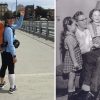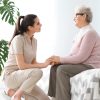
More and more seniors are living alone, away from family, than ever before. What kinds of everyday tasks do they need help with? And what health benefits to they get from this help?
Nearly half of people age 65 and older need help with routine daily activities, and most of this help is performed by friends and family, and not by professional caregivers. For example, in the United States at least 18 million people require help with routine daily activities like bathing, handling medications or meals. This number is only expected to increase in coming years as the population ages.
According to a 2014 report, 29 percent of people over the age of 65 reported receiving help with taking care of themselves or getting around in the previous month. Another 20 percent reported that they had difficulty carrying out these activities on their own.
The implication is that we, as a society, must do more to improve services and support for not only these seniors, but also their spouses, their children and “informal caregivers”—family members and friends who provide daily help to people who are either temporarily or permanently unable to function independently.
Providing more help will help prevent “caregiver burnout” while improving the quality of life for seniors. The question is, what kind of help do seniors need?
What Does It Mean When 20 Percent of Seniors Say They Need Help With Daily Tasks?
The first challenge is really understanding what it means when 20 percent of people are reporting they need help with daily tasks.
“There’s a ‘Twilight Zone’ area between those who are perfectly fine and those who aren’t, and these are the people who can probably be helped most with rehabilitation therapy or assistive devices,” says one expert who specializes in rehabilitation.
To help better understand what kind of help seniors need, a 2013 study identified “four levels” on the disability spectrum. These four levels describe people who are fully able to:
- Use special devices to work around their disability
- Have reduced the frequency of their activity but report no difficulty
- Report difficulty doing activities by themselves, even when using special devices
- Get help from another person.
Using this classification, geriatric researcher Vicki Freedman and her colleagues found that 31 percent of adults older than 65 were able to take care of themselves with no assistance. About 25 percent were able to take care of themselves using some sort of assistive device, such as bathroom grab bars or a cane.
Another 21 percent received help from other people, and 18 percent reported having difficulty completing daily tasks even with accommodations. About 6 percent of the study subjects scaled back on certain activities.
“Some Seniors Need an Average of 200 Hours of Care a Month”
The end result was that these adults need, on average, about 200 hours of care per month. Informal caregivers, mainly spouses and children, provided most of that help. About three in ten older adults who received assistance supplemented this informal care with paid help.
Effectively coordinating support is going to become even more important as more and more older people living with disabilities receive care at home, rather than in a care facility or hospital, says Brenda Spillman, a senior fellow with the Urban Institute’s Health Policy Center.
There are more issues than just managing caregiver burnout and improving quality of life, says Spillman.
“About one in three people who reported help or difficulty with daily activities also reported having at least one adverse consequence related to having an unmet need for help in the month prior to the interview,” Spillman says.
So, what kinds of help do people actually need?
1) Mobility
Mobility is important to the elderly, even if it is just within their own surroundings. Make sure they are properly fitted for either a wheelchair, motorized mobility chair, walker or cane. Install a wheelchair ramp, hand rails and wider door wells to make getting around the house hassle-free. A hospital bed, shower chair, lift or tripod bar may assist with getting up from bed or staying safe in the shower.
2) Medication
Senior citizens may need proper medication to remain healthy. This begins with adequate medical care, such as doctor’s visits, dental care, foot care, eye care, physical therapy and psychiatric therapy, if needed. If they need assistance with taking their pills or giving themselves shots of insulin, a home-health nursing system may need to be added to their daily plan of care.
3) Transportation
Transportation can be lifesaving to an elderly person. If they can no longer drive, set up transportation so they can get to and from medical appointments and physical therapy. Having a caretaker or assistant who visits on certain days to take an elderly person to run errands, to attend a social function or to go to the doctor is beneficial.
4) Personal Care
Personal care is an important daily need for a senior citizen. They may need assistance with bathing, dressing and personal grooming. A home-health aide or other family member can help with these tasks, if necessary.
5) Nutrition
Everyone needs proper nutrition to stay healthy and enjoy a comfortable life. Have a nutritionist or caregiver go over a daily meal plan to know what foods best fit that person’s lifestyle. Meals can be prepared weekly so it is easier for the senior citizen to heat and eat a warm meal every day. Programs such as Meals on Wheels ensure that an elderly person receives at least one healthy meal daily.






